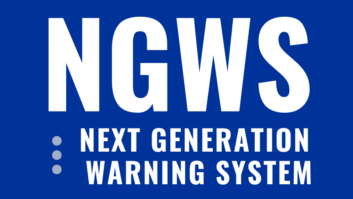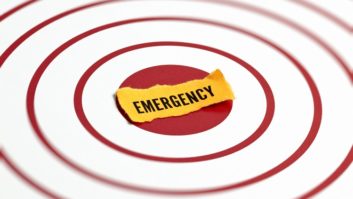EAS was designed for AM radio. EAS for TV was a clumsy afterthought. Cable, streaming and interactive multimedia even more so.
I argue that with NextGen Broadcast on the horizon, it makes sense to turn around and look forward. If key OTA radio services migrate to UHF multimedia, and if 3.0 chips in cars and phones preserve radio’s access to those key destinations, broadcasting’s relationship to emergency alerting and informing changes for the better.
Allow me to explain.
Lack of enthusiasm
It’s amazing that EAS hasn’t been replaced. A lot has happened since 1997 when EAS was formally adopted. Listenership has continued to move from AM to FM. Many listeners have then moved on to every other thing that we listen to on a smart speaker or in a car. News radio is a disappearing niche. And of course, the internet changed everything.
When it comes to emergencies, EAS is the new EBS — its archaic FSK tones lovingly preserving the sound of 20th century acoustic modems.
When we happen to catch an actual on-air EAS (not the dreaded weekly/monthly “cry wolf” that signals us to change stations), we go fast and first to … our smartphones and maybe a TV!
This behavior is substantiated by research. Odds are far better that our phone’s WEA or an opt-in alerting app woke us up, not that EAS served a role.
It’s embarrassing when we say things like “we need AM in cars for EAS” or “we need complex hacking protections for EAS (although we don’t change default passwords).”
We only hear about the value of EAS when someone wants something.
Back in 1988, when we were carrying around prototype EAS boxes, there wasn’t much interest in “fixing” EBS either.
Some things don’t change, like the NAB representing broadcast owners’ opposition to spending money on such things. Recent efforts to virtualize EAS are just the latest commotion to squeeze pennies and further reduce the “burden” of this public service on broadcasters.
Recently, a small story on CBS advised people in tornado zones to buy weather alert receivers because many stations don’t broadcast tornado warnings, and because broadcast radios don’t have a “auto-wakeup” function. (Oddly enough, wakeup is better supported by EAS, which has 10 times the location resolution of NOAA’s Specific Area Message Encoding.)
But the recent big story is that the United Kingdom is launching a well-sourced, unified, national, smartphone-based alert system. America has something like that too: Wireless Emergency Alerts (WEA) on your smartphone. And internet-based, proprietary, opt-in alerting services like Everbridge, AlertMedia and dozens more that have been purchased by cities and counties.
During roundtables with emergency managers, emergency management webinars and even FEMA IPAWS presentations, the lack of enthusiasm for EAS and “old tech” like radio and TV is palpable. Cellphones are now the Swiss-army knives for emergency notification and management.
EAS replaced the EBS daisy-chain with the EAS mesh network. Each receiver looks at two or more over-the-air stations, making the alert distribution nearly bulletproof. The broadcast-to-broadcast mesh (unlike the IPAWS and IP management ports) is extremely hard to hack, and one can weave in weather radio, public safety radio, satellite and other connectivity.
Modern alerting needs two things that broadcasters provide.
The first is the survivability of high-power broadcast. Internet independence is absolutely necessary for emergency alerting and informing. Smartphone-based systems are wonderful, but their use in an emergency is perilously limited by the fragility of the wireless network they are on. This is not a minor drawback.
Only one broadcaster needs to survive to serve a community’s emergency needs. Every cell tower that burns up, falls, floods, runs out power, loses fiber or gets oversubscribed with urgent emergency information requests, cuts off a significant number of people, usually those needing it most.
This isn’t fantasy. No emergency yet has ever left us without broadcast coverage. Significant event postmortems have frequently found that mobile wireless networks have been a dangerous impediment.
The second thing broadcasters do is aggregate, validate, present and distribute information. Almost unique to America, we have many agencies at all levels of government and some industries (think nuclear or chemical plant) that can and should issue lifesaving alerts. In the U.S., not one of them has the 24/7 ability of a basic TV newsroom to put multimedia information out quickly via multiple distribution channels.
It’s not about the alert; ringing a bell is easy. It’s about the concise, critical information that should follow. Local TV — and, where available, radio news outlets — work hard to earn trust. While a smartphone can (as they work the bugs out) deliver a reasonably targeted alert to even sleeping populations, your best and often only shot of reaching critical information comes from a local news station.
It is pretty obvious that the best of all possible emergency alerting and informing technologies is to broadcast emergency alerts and high-quality information primarily over a resilient mesh of high-power transmitters to a world filled with enabled smart devices such as smartphones, TVs, cars, smart speakers and talking fire alarms.
[Sign Up for Radio World’s SmartBrief Newsletter]
Redirect the energy
Those who know NextGen Broadcast are quick to point out that the ATSC 3.0 standard and implementation planning road map all but beg for this best of all possible systems.
To the best of my knowledge, only Sinclair has made progress. Their recent NAB demo is a spot-on demonstration of the key advantages, like user-controlled filtering, a non-invasive experience and instant access to relevant, critical content.
Sinclair hasn’t yet fully integrated this into the emergency ecosystem or tightly tied it to news operations or attempted a real-world end-to-end demonstration. It’s a good start. None of this is more than a typical mid-sized development project.
It’s time to stop the silly talk and wasting resources on insignificant tweaks. It’s time to direct this energy instead to the next generation of alerting and informing.
There is some recent government money and the usual feeding frenzy and magical-thinking proposals that chase such funding. The point of government investment is for the public good to invest in what the industry doesn’t have enough incentive or cohesiveness to do on its own. NextGen alerting and informing should be what FEMA insists our tax dollar buys.
GPS backup is related to this discussion, and it is critical. Whether from a solar flare or a cyber incident, sooner or later we will learn what happens when our essential timing and location system is compromised.
Location is everything in an emergency. If FEMA/FCC required every UHF 3.0 station to host their gear and give up a few bits, at the end of a future GPS replacement cycle, civilization can continue with timing received from a UHF NextGen chip. The Broadcast Position System deserves a lot of attention (beyond IEEE and NAB) from FEMA/FCC in the context of how we reinvent broadcast to manage disasters.
A parting thought
EAS is likely going to be with us as long as analog radio and 1.0 DTV are. Also, even the most isolated, tech-adverse or disadvantaged citizens have radios.
In the next world, on next-gen devices, interrupting programming for EAS will be reserved only for the most dire threats to life. The rest of emergency information content — and in emergencies, content is king — will be served quite differently to audiences.
You might not have noticed, but advanced emergency alerting will serve a very useful purpose for broadcasters: It seamlessly and with little friction pushes people seeking information to our news products.
If our future is news — the one content product where we have a right to win — NextGen Broadcast is the best thing that can happen.
One would think that the more dominant community centric radio stations will find it advantageous to be on the NextGen Broadcast platform, which doesn’t suffer from the reception limitations that AM/FM radio does. One would think that HD-FM today — and someday all-digital AM and all-digital FM — would integrate tightly with NextGen.
The benefits of advanced emergency alerting and informing extend to radio programming as well. When driving to flee a fire or in an organized mass evacuation, one should be able to listen to a calming radio voice while occasionally glancing at the NextGen-delivered escape route map.
Through the EAS dust cloud we’ve spun up, it’s easy to understand why the emergency community, regulators, organizations focused on emergency alerts and even we broadcasters have not converged on that simple vision: smart devices on a broadcast backbone.
That said, there are no bad guys here. Broadcasting and the myriad of other stakeholders are consensus organizations. There is no small group of well-resourced visionaries investing in a disruptive product. While NextGen alerting and informing is the convergence of well-known, mature technologies and both the broadcaster’s ability to produce critical content and the emergency community’s ability to pinpoint threats and manage emergencies — no one has ever seen, held or pushed a button on anything like this. The convergence is larger than the sum of the parts. Smartphones themselves are impossible to explain in words to people who know only a dial phone. Right now, the whole idea that something would wake you, guide you through an evacuation and save your life with seconds to spare is science fiction. It should not be.
[Also by this author: “NextGen TV Is Tapping Us on the Shoulder”]







